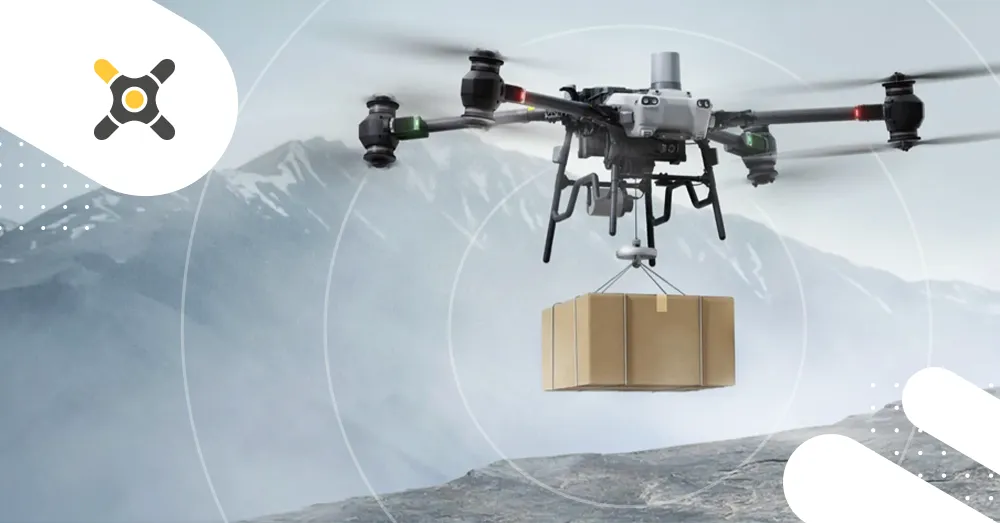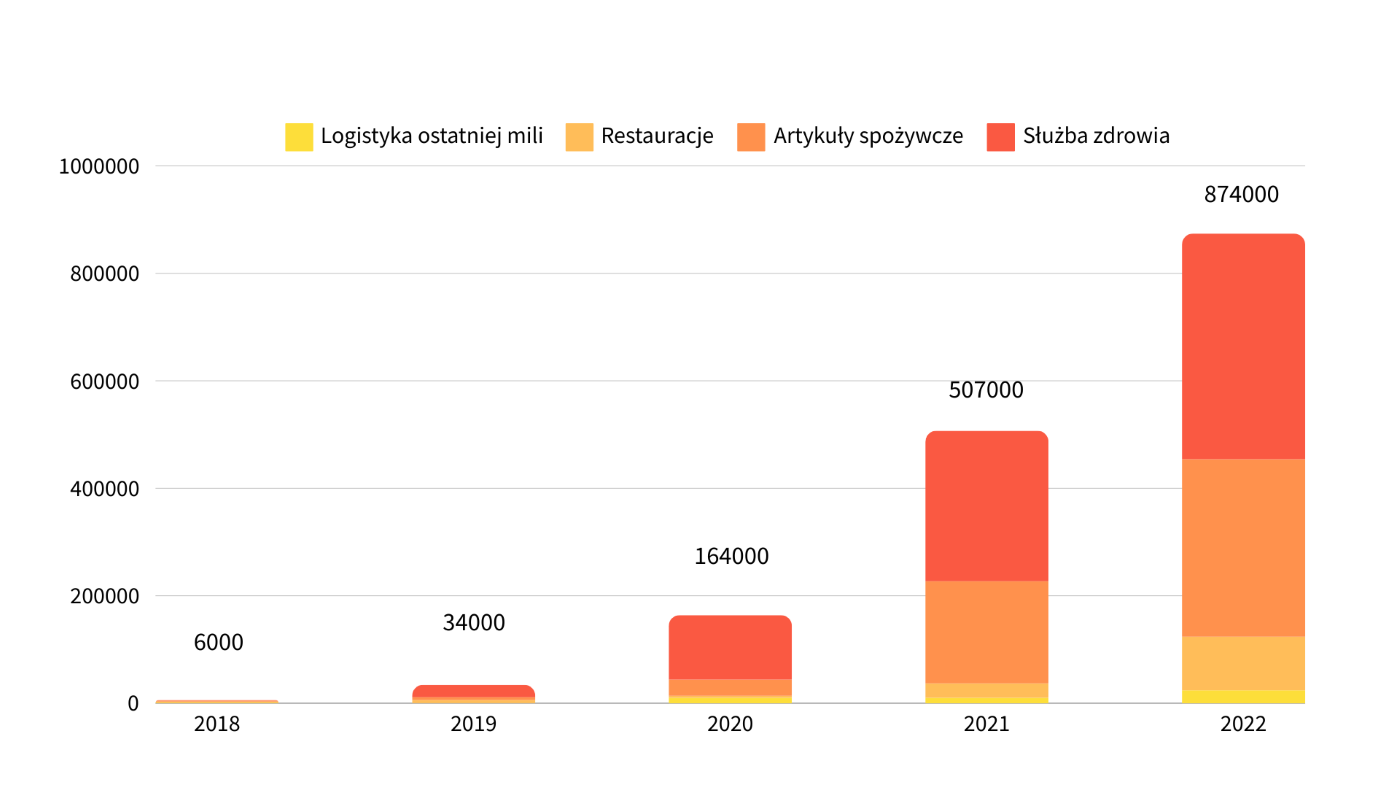Drones the future of package delivery - is it possible?

Drones, which until recently were mainly associated with the military or entertainment, are becoming a key element in the logistics industry. The technology is developing rapidly, and companies around the world are already testing or are implementing drone deliveries as part of its offer. What is the current status of this technology? What are its capabilities and limitations?
Global Growth in Popularity of Delivery Drones
As of 2019, the popularity of drone deliveries began to soar, largely as a result of the COVID-19 pandemic. The contactless form of delivery has proven to be a a safe and convenient alternative for traditional methods. In 2022, the global number of package deliveries by drones increased by more than 80%, reaching almost 875 thousand shipments worldwide. Most drones were used to transport healthcare products and necessities.
Commercial drone deliveries by type of application

Drones have gained popularity for their ability to bypass traffic jams and reducing delivery times, which is especially important in industries such as e-commerce and catering, where customers expect fast order processing. However, there is also no shortage of critics who believe that drones only "patch" the problem of road congestion, and instead should be invested in infrastructure upgrades.
Market Leaders: Amazon, Wing and UPS
At the forefront of drone delivery development are giants such as Amazon, Wing (a subsidiary of Google) and UPS. Amazon Prime Air is conducting tests in California and Texas, enabling deliveries in a dozen minutes, and in 2023 received approval from the Federal Aviation Administration (FAA) to fly drones. Wing, in turn, operates in Australia and the United States, delivering packages and groceries from local stores. UPS has focused on medical supplies, using drones to quickly transport drugs and medical samples.
The most dynamic development of commercial services of delivering small products by drone is observed in the USA. However, when it comes to the number of packages delivered, the Asia-Pacific region leads the way. These areas saw the highest number of deliveries in 2022, driven by the growing demand for rapid transportation, especially in the medical industry.
Right behind them is Africa, which may seem surprising at first, but given its underdeveloped road infrastructure and urgent need to deliver medical equipment, the popularity of drones in the region becomes understandable. In Africa, more than more than one million deliveries, and with this technology, hospitals have reduced blood waste by 67%. Europe, North and South America are lagging behind in the number of drone deliveries, but interest in the solution is growing worldwide.
Examples of Drone Deliveries in Europe and Poland
In Europe, one of the leading companies in drone deliveries is Ireland's Manna, which offers consumer product delivery services in Dublin.
In Poland, this technology is also slowly taking its first steps:
- In May 2021, a drone of the Decathlon chain landed in Lublin to deliver an order to a customer. It was a watershed moment for the Polish e-commerce market.
- Spartaqs, on the other hand, delivered COVID-19 samples between Warsaw's MSWiA and UCK WUM hospitals, which took only 2.5 minutes.
- In August 2024, a major food supplier began testing drone deliveries in the Mazowieckie province.
Although Poland and the Union are still working on legal and procedural regulations for drone deliveries, these early projects show that the future of the technology looks promising. In Poland, public opinion is positive about drone deliveries - As many as 81% of Poles believe that drones will deliver packages to their homes in the future. Details can be found here.
Challenges and the Future of Drone Delivery
Despite growing popularity, drone deliveries face many challenges. A key problem is regulation - different countries have different laws on drone use, which delays their widespread use. U-Space regulations are being developed in Poland and the European Union to facilitate the large-scale introduction of this technology.
Another challenge is residents' concerns about noise, safety and potential collisions with other objects. The weight of shipments is also an important limitation - most consumer drones can carry loads weighing between 2 and 4 kg, although models already exist, such as FlyCart 30 from DJI, capable of carrying loads weighing up to 30 kg.
And don't forget about weather conditions, which have a huge impact on the ability to use drones. Rain and strong wind greatly limit their operability, although we are seeing the development of techniques that allow drones to fly even in heavy rain.
Advantages and Potential of Drones in Logistics
One of the most important advantages of drone deliveries is their speed. Drones avoid traffic jams by taking the most efficient routes, giving them a significant advantage over traditional transportation methods. They are also ideal for delivering goods to hard-to-reach places, such as rural areas or areas with poor infrastructure.
Drones can also help reduce transportation costs by eliminating expenses related to driver hiring and fuel consumption. It is also worth noting their ecological nature - they reduce CO2 emissions, which is an increasingly important argument in the context of climate change.
Summary
Drones have enormous potential potential to revolutionize the logistics industry, offering faster, more efficient and environmentally friendly delivery methods. While there are still many challenges ahead, the development of this technology is progressing rapidly, and more and more companies see it as the future of logistics. What supplies will look like in a few years? Time will tell, but one thing is certain - drones will play a key role in them.
Sources:
- https://www.mckinsey.com/industries/aerospace-and-defense/our-insights/future-air-mobility-blog/commercial-drone-deliveries-are-demonstrating-continued-momentum-in-2023
- https://ti-insight.com/briefs/flying-high-the-global-ascendance-of-drone-delivery/
- https://dronenews.africa/the-flip-side-of-the-delivery-drone-boom/
- https://www.forbes.com/sites/annefield/2024/04/27/ziplines-milestone-1-million-commercial-drone-deliveries/
- https://bizblog.spidersweb.en/spartaqs-drones-hospital-covid-couriers

